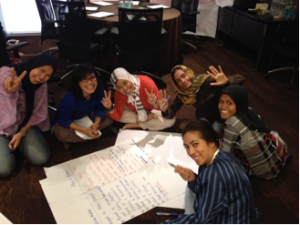7 Social Movements and Advocacy
Learning Objectives
After reading this chapter, you should be able to:
- Read about the theories of social movements and advocacy.
- Understand the role of nonprofit organizations in social movements and advocacy.
- Practice advocacy skills.
7.1 Chapter Introduction
So far in this textbook you have learned about the service role of nonprofit organizations. You’ve also learned about the ways that nonprofits partner with government to deliver public goods. However, nonprofit organizations are also central players in movements for social and policy change. Sometimes they engage in policy change in partnership with government by serving on commissions, task forces and committees alongside public officials. Other times they are in conflict with government by engaging in efforts to change the status quo and improve public policy to solve social issues, protect the environment and improve human rights protections. Some of these efforts are part of larger social movements, which are often made up of many nonprofit organizations, businesses and community leaders.
As part of their advocacy efforts, nonprofits help to inform the public about issues before policymakers and help to educate policymakers about issues facing communities. They also often represent historically marginalized communities before policymakers and identify potential policy solutions.
In this chapter, we will define advocacy and social movements, describe the roles of nonprofit organizations in engaging in these activities and efforts and learn about different advocacy tactics organizations and individuals can support to create change.

Activity
Brainstorm a list of all the ways that individuals and organizations can speak up on community or policy issues. Identify organizations that engage in one or more of the activities you listed.
Image: “Advocacy and Mobilization Workshop” by inclusivesecurity is licensed under CC BY 2.0.
7.2 Defining Advocacy
Simply put, advocacy is speaking or acting on the behalf of others.”[1] It is an umbrella term that includes many different types of advocacy activities – some of which are regulated by the United States government, depending on the type of nonprofit an organization is.
7.3 How Nonprofits Advocate
According to Kelly Leroux and Mary Feeney[2], nonprofit organizations engage in several different roles in their advocacy:
- Representation. Nonprofits represent the interests of certain groups before policymakers. Sometimes, that can be taken literally by representing clients in courts through litigation or lawsuits. However, nonprofits often do this through direct lobbying – in Congress, state legislatures, or at the local level – or by presenting petitions or public testimony to decision makers. Through representation, nonprofit organizations help to raise community issues before policymakers and offer solutions for change.
- Political Mobilization. Nonprofit organizations help to mobilize the public. They might do this by organizing petition drives, encouraging people to vote or attend public hearings and rallies or by recruiting and training individuals to lobby their own legislators or do media outreach. Through political mobilization, nonprofit organizations help connect the public to their elected officials.
- Education. Nonprofits also have an important role in education around policy and political issues. They help inform the public about how their representatives vote on particular issues, and they help increase awareness around issues they are working on. Some nonprofits, such as think tanks like the Brookings Institution and other organizations, may conduct their own policy research, researching problems and identifying potential policy solutions.
It’s important to recognize that nonprofit organizations may engage in one or more of these roles simultaneously.
IRS Regulation of Advocacy
In Chapter 1, we discussed the different types of tax-exempt nonprofit organizations defined by the Internal Revenue Service (IRS). The type of nonprofit an organization chooses to become may have implications for what type of advocacy tactics that organization can get involved in. Specifically, the IRS regulates the role of nonprofits in direct lobbying and electioneering (campaigns for office) activities. Lobbying is defined by the IRS as “attempting to influence legislation. A 501(c)(3) charitable organization may engage in some lobbying, but too much lobbying activity risks loss of tax-exempt status.” Note that the IRS doesn’t define what “too much lobbying” is. This definition also doesn’t include meeting with agency secretaries (such as “lobbying” the Environmental Protection Agency). So, in short, lobbying is ONLY about talking to a legislator about legislation (a specific bill). On the other hand, 501(c)(4) social welfare and mutual benefit organizations, along with several other types of organizations, are allowed to engage in unlimited direct lobbying. 501(c)(3) charitable organizations also are not allowed to engage in any electioneering activities except for voter registration, get out the vote drives and a limited amount of voter education as long as it doesn’t endorse a candidate.
501(c)(4) groups can engage in some electioneering, including endorsing candidates and giving money to other nonprofits such as Political Action Committees (PACs). Again, the IRS doesn’t provide a threshold to determine what amount is “too much.”
Because of the ambiguity of some of these rules around advocacy, some groups form more than one nonprofit in order to engage in different activities. For example, HRC (in our example above) has a 501(c)(3), a 501(c)(4) and a Political Action Committee of its own (which allows them to give money directly to candidates for office). Although each of these organizations are legally autonomous, they often operate under a single mission and sometimes are supported by the same group of staff members.
As a nonprofit manager, it’s important to know which type of nonprofit your organization is and what advocacy activities you are able to engage in.

Activity
The Human Rights Campaign is a national LGBTQ (lesbian, gay, bisexual, transgender and queer) advocacy organization.
Their mission is “to end discrimination against LGBTQ people and realize a world that achieves fundamental fairness and equality for all. HRC envisions a world where lesbian, gay, bisexual, transgender and queer people plus community members who use different language to describe identity are ensured equality and embraced as full members of society at home, at work and in every community.”
Following a wave of anti-LGBTQ legislation introduced in state capitals across the country in 2022, HRC was not only working at the federal level in Washington, D.C., but was also helping to organize and represent the LGBTQ community nationwide, from Juneau, Alaska to Tallahassee, Florida.
Review HRC’s website. Which role(s) do they play in advocacy? Refer to Leroux and Feeney’s typology of representation, mobilization and education.
7.4 Advocacy Activities
Take a minute to think about all the ways that you or your friends and family have worked to “speak on behalf of a cause.” Can you list some of them?
Organizations may use many different types of activities to advance their policy agenda or to stop legislation or laws they oppose. Below is just a sampling. Can you think of others?
- Lobbying – Lobbying is just one form of advocacy activity and one of the only ones that the IRS and some states try to regulate and monitor. Review the box on the IRS definition of advocacy for more information.
- Litigation – Many nonprofits file lawsuits against a local, state or federal government or agency, or sometimes even a corporation. Sometimes nonprofits will file suit in order to enforce implementation of a law or to stop a law from taking effect. They may also seek to change the law through judicial action.
- Grassroots lobbying – There are a lot of activities that fall under this category, including lobby days, petition gatherings, phone banking and letter writing campaigns. Through these activities, nonprofits help citizens communicate their opinions, values and beliefs with lawmakers.
- Raising awareness – Nonprofits are often very active in educating the public about issues before decision makers. Activities that raise awareness may support grassroots lobbying, but they can also be used primarily to help sway public opinion or educate communities on particular issues. These types of tactics include town hall meetings or other types of community gatherings and events, rallies and marches, media outreach and engagement, newsletters or social media posts or dissemination of policy research.
- Electoral activities – Although electoral activities, like lobbying, are regulated by the IRS, nonprofits often are leading actors in candidate and ballot measure campaigns. They help register voters, educate them on the issues and turn them out to vote. Most nonprofits are also able to host nonpartisan candidate forums [pdf], where all candidates for office are invited to share their positions on the issues facing the community. Some types of nonprofits are even able to endorse candidates and provide them campaign contributions or work on their behalf.
- Direct Action and Civil Disobedience – Sometimes using the above tactics isn’t successful in winning the social or policy change that organizations seek. At other times, issues are too urgent to wait for Congress or a state legislature to act. And sometimes communities are frustrated with the lack of action by decision makers. In these cases, nonprofit organizations may sponsor certain types of direct action activities. These activities are designed to generally raise awareness by disrupting public spaces, and may include street blockades, holding a sit in at a local business or government office, strikes, boycotts and tree sitting. The goals of these activities are usually to generate public attention and support through the media and also increase pressure on lawmakers to act quickly.
While some nonprofit organizations may focus on one advocacy technique, many organizations engage in several tactics, sometimes simultaneously. Nonprofit boards of directors and staff are tasked with identifying which tactics may be appropriate based on their mission and goals and their stakeholders’ expectations.

Activity
Your voice matters too! Think about an issue you are concerned about. Spend a few minutes researching the basic facts of the issue. Consider exploring the website of a nonprofit that is working on the issue you care about.
Then, write a short letter to the editor to your local newspaper.
Letters to the editor are usually only 100-250 words, under your own name, that summarize an issue, point out the relevant facts people should understand and often suggest a possible solution or a different point of view. Review some examples at The Washington Post before you begin.
Image: “Newspapers” by Lydia licensed under a CC BY 2.0 license.

Can Nonprofits Solve Social Issues Through Advocacy?
Although many, if not most, nonprofits engage in some form of advocacy efforts on behalf of their organization or beneficiaries, community and members, there have been growing demands for nonprofits to do more. This is particularly the case when nonprofits are hesitant to be adversarial with government for fear of jeopardizing their tax-exempt status, losing donor support or being perceived as too polarizing, “political” or partisan. Instead, these groups may seek to maintain a more neutral position when it comes to policy or social change, particularly when a topic is deemed controversial, such as racism, sexism, homophobia, income inequality, climate change, immigration, LGBTQ rights and others.
Some nonprofit activists and scholars are calling for the nonprofit and philanthropic sector to be more willing to stand together in an effort to dismantle the historical systems that are responsible for bias, discrimination and inequality. Others have called for the nonprofit sector itself to “do better” in creating just and equitable organizations. Read one or both of the articles found at the links in this paragraph and think about the following questions:
- What are the risks to nonprofit organizations if they appear “too political” to some of their supporters? What are the benefits of appearing to stay neutral in policy battles?
- Should nonprofits consider donor wishes when thinking about advocating on behalf of their beneficiaries? How should managers balance the wishes of their different stakeholders?
- Should nonprofits, regardless of their mission, be involved in social or policy change? What if they only have limited resources to do so? Should they move money away from services to advocacy? Why or why not?

